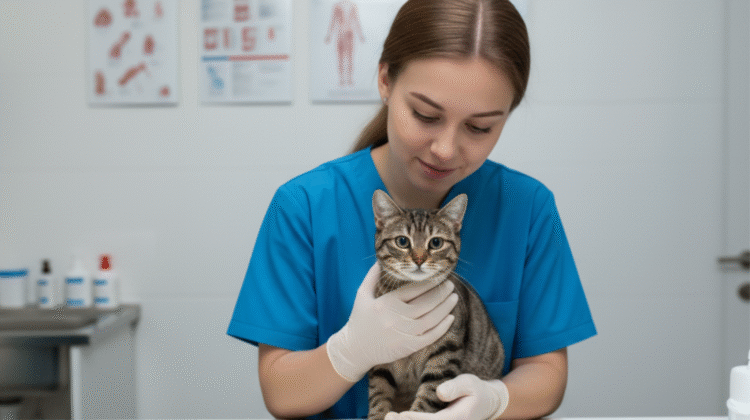
Why Timing Matters More Than You Think
Bringing a kitten home is pure joy—tiny paws, curious eyes, and endless play. But soon after, the big question arises: how old must cats be to get fixed?
It’s not a small decision. Fixing too late can mean unwanted pregnancies, spraying, or health problems. Doing it too early may raise doubts for some owners. The good news? Veterinary science gives us clear guidance. Let’s unpack the when, the why, and the how so you feel confident making the best call for your furry companion.
What “Getting Fixed” Really Means
When a cat is “fixed,” it means spaying or neutering surgery.
- Spaying (females): Removal of ovaries and uterus. This ends heat cycles and prevents pregnancies.
- Neutering (males): Removal of testicles. This lowers testosterone and prevents breeding.
Both are simple, common surgeries done worldwide. Most cats recover quickly and return to regular play within days.
Decades ago, vets advised waiting until six months. Today, research shows that kittens as young as eight weeks old can be safely fixed if they weigh at least two pounds.
The Right Time to Schedule the Surgery
So, how old should your cat be? The answer depends on health, weight, and your vet’s advice:
- Early-age option: 8–12 weeks old (minimum two pounds). This is often done in shelters before adoption.
- Traditional timing: 5–6 months old. This is still very common and prevents puberty changes like heat cycles or spraying.
- Adult cats: Any healthy cat can be fixed at any age. Even seniors can benefit, though recovery may be slower.
The key is not just age—it’s health and weight. Always let your vet guide the decision.
Why Fixing Your Cat Improves Life at Home and Beyond
Protecting Your Cat’s Health
Female cats spayed before their first heat have up to 90% lower risk of mammary cancer. They also avoid dangerous uterine infections. Male cats neutered early won’t face testicular cancer and are less prone to prostate issues.
Smoother Behavior at Home
Neutered males are less likely to spray furniture or fight other cats. Spayed females avoid the restless meowing, rolling, and pacing heat cycles bring. Fixed cats usually stay closer to home and focus more on bonding with humans.
Saving Money Long Term
One surgery is far cheaper than emergency care for pregnancy complications, fighting injuries, or caring for surprise litters. Many local clinics even offer reduced-cost spay/neuter days.
Supporting the Community
A single unspayed female can produce thousands of kittens in her lifetime through her offspring. Fixing helps cut down on stray numbers, eases pressure on shelters, and builds goodwill in your neighborhood.
Clearing Up Myths and Misunderstandings
Many cat owners hesitate because of old myths. Let’s set the record straight:
- “Cats should have one litter before spaying.” Not true. No medical benefit exists. In fact, earlier spaying is healthier.
- “Fixing makes cats fat.” Weight gain comes from overfeeding and lack of exercise, not surgery itself.
- “Indoor cats don’t need it.” Even inside cats benefit. Heat cycles and spraying still happen indoors.
- “It’s cruel or unnatural.” The surgery is quick, safe, and reduces suffering from overpopulation.
What the Procedure Looks Like
Knowing what happens helps reduce worry. Here’s a simple breakdown:
- Your vet checks your weight and overall health.
- The cat is given anesthesia to prevent pain.
- Surgery takes 15–30 minutes.
- Most cats go home the same day.
Kittens often bounce back in 24–48 hours. Adult cats may need a bit more rest.
Helping Your Cat Heal Smoothly
After surgery, a little extra care speeds recovery:
- Keep them indoors and calm for at least a week.
- Check the incision daily for swelling or redness.
- Use an e-collar if they try to lick the stitches.
- Provide a soft, quiet space for rest.
Your vet may prescribe pain relief. Follow every instruction carefully. With good care, healing is usually quick and trouble-free.
What Happens If You Wait Too Long
Delaying the surgery can bring real risks:
- Females may develop infections or cancers tied to hormones.
- Males might become aggressive, spray, or wander miles away.
- The risk of accidental littering skyrockets.
Even if you missed the “ideal” age, fixing later is still far better than never.
The Future of Cat Sterilization
Veterinary care keeps evolving. Newer methods may soon offer non-surgical sterilization through injections or implants. These could make fixing even easier and less costly worldwide.
At the same time, shelters and rescue groups push education harder than ever. The goal? Every adopted cat leaves already fixed, cutting unwanted litters before they start.
Wrapping It All Up
So, how old do cats need to be to get fixed? The safe range starts at eight weeks, with the most common timing around five to six months. What matters most is preventing heat cycles, avoiding accidental litters, and protecting long-term health.
Talk to your vet about your cat’s specific needs. This will give your pet a healthier future and help reduce the cycle of homeless cats in your community.
Quick FAQs
Q: Is it ever too late to fix a cat?
No. As long as they’re healthy, cats of any age can be fixed.
Q: Do male cats calm down after neutering?
Yes. They’re less likely to fight, roam, or spray.
Q: How long is the recovery?
Most kittens recover in two days. Adults may take up to a week.
Q: Can my indoor-only cat skip surgery?
Not recommended. They still face health risks and behavior issues.
Q: Is it expensive?
Costs vary. Local shelters often provide low-cost options.
Read More: Do Male Cats Have Nipples


Leave a Reply